Early Office Museum
Antique Stapler Gallery
~ Magazine Stapling Machines ~
A magazine stapling machine has a place where multiple preformed staples are stored ready for use.
Knobs vs. Levers
For many years, some stapler models had knobs on top, and in many cases the operator was required to hit the knob with his/her hand to insert and clinch a staple. For some models, rubber caps for the knobs were available to protect hands. Other stapler models used levers, which were pressed rather than hit. Some advertisements for staplers, including some with knobs, stated as a benefit that "no pounding" was required.
The Development of Refills for Magazine Staplers
In 1878, William J. Brown, Jr., received US Patent No. 210,748 for a rod, made from wood or other material, on which a number of individual staples that were not connected to each other could be mounted and encircled by a wire to hold them in place. When a user wanted to load the staples into a magazine stapler, the encircling wire was removed and the staples were pushed off this rod into the stapler's magazine. Until the mid-1920s, this was the way staples were sold for magazine staplers. However, this was about to change.
Insert patent image and catalog image.
A Bostitch company history states that the Boston Wire Stitcher Co. (later known as Bostitch) introduced the first "cemented strip staples" in 1924 (bostitch.com, 11/1/2015). We have not found evidence to support the claim regarding the introduction in 1924. However, on Oct. 1, 1925, an inventor affiliated with the Boston Wire Stitcher Co. applied for a patent for strips of staples formed in the following way: first, a strip of tissue paper was attached to the underside of a row of staples; second, an adhesive was sprayed onto the staples, "cementing" them together. When the cemented strips of staples were inserted into a stapler, the tissue was still attached. The tissue was destroyed as the staples were used to fasten papers. We have not found an advertisement for or an example of this type of staple strip. US Patent No. 1,665,051 was awarded in 1928.
A 1927 ad for the “New Model Hotchkiss Wire Stapling Machine” stated that “while each staple is a unit and already formed, the whole string of 250 is ‘frozen’ or soft-leaded together.” These 1927 Hotchkiss frozen wire staples were sold on a strip of metal with a wire over the top of the staples. Hotchkiss was still selling this type of staple stick in 1930.
By contrast, a 1928 advertising image shows sticks of staples that were soft-soldered together for use in Neva-Clog staplers, and these sticks were not on rods encircled by wires. The sticks appear identical to the sticks of staples sold for staplers today. The same was true for the Hotchkiss staple sticks sold in the box below, which may date from the 1930s.

Hotchkiss "Soft Leaded" Frozen Wire Staples
In 1929, an inventor affiliated with Bostitch applied for a patent for strips of individual preformed staples held together solely with glue and no longer mounted on a rod. US Patent No. 1,792,235 was issued in 1931. The patent application stated: "It has before been proposed to assemble staples in stick form by attaching them together with solder [or] by pasting a strip or strips of paper along their top and sides. None of these methods has been satisfactory." The application also stated that an object of its invention was "to provide a staple stick or refill package in which the staples are held together without the use of a central core or support and without an outer wrapper or extraneous binder." The application further stated that "I have devised a method of bonding or fastening the staples together in a unit or stick by applying a coating of adhesive to their under and inner sides which will not interfere with the operation of the stapling machine." Staples that were “glued” together were marketed until at least 1936 as “Cohered” or “Frozen” wire staples.
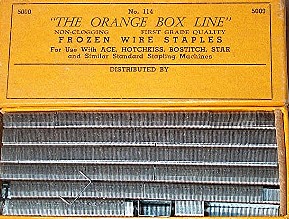
Glued Frozen Wire Staples
|
Model, Year Introduced, Maker |
Click Image to Enlarge |
Brown Office Pet Paper
Binder
Patented 1879 ~ On market 1880 ~ Advertised 1881
William J. Brown, Jr.
Philadelphia, PA
The machine in the photo is a slightly modified version of the machine in the 1881 advertising illustration.
|

 |
No. 5 Breech Loader Stapling
Machine
Patented 1887 by William J. Brown, Jr., Philadelphia, PA ~ Advertised 1886-1902, 1910, 1922
Advertised by the Wire Staple Co., Philadelpia, PA, in 1886. This was the name of Brown's company during at least 1885-89.
Product reviews published during 1899-1900 identified Samuel J. Yarger, Philadelphia, PA, as the supplier of this machine, and small oval brass plates on some examples of this machine have Yarger's name. Yarger manufactured a wide range of wire stitching and binding machines used by printers during the decade beginning in 1899.
Brown changed his company's name to Acme Staple Co., Ltd., in 1894. This machine was advertised as the Acme No. 4 in 1910.
Yarger and Acme were different manufacturing companies.
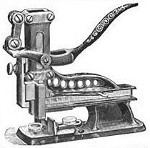
Advertisement for No. 5, 1889. This image, which corresponds to that in the 1887 patent, appeared in ads during 1886-92.
There are minor differences between the machine in the image above and the machine in the photos to the right, e.g., the image above shows a row of holes along the spine of the machine. Those holes no longer appear in the image used in ads from 1893 onward.
There is a distinct No. 6 model.
|

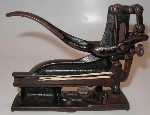
After one places staples on the rail that that is visible, in part behind and in part below the rubber band, one reinserts a sheet metal part and attaches a rubber band a hook on that part and a hook on the machine to put forward pressure on the staples in the magazine. |
McGill Magazine Staple Press
Advertised 1887-89
Holmes, Booth & Haydens
New York, NY |
 |
Office Pet No. 2 Paper
Fastener
Patented 1895 ~ Advertised 1895
Acme Staple Co., Ltd.
Philadelphia, PA |
Picture coming |
Sure Shot Paper Fastener
Patented 1894-95 ~ Advertised 1898-1937
Acme Staple Co., Ltd.
Philadelphia, PA (1894-1909) & Camden, NJ (1909 onward)
There were two models, one with a convex back and the other with a concave portion along the back. Illustrated ads during 1898-1920 show the first of these.
Each model was available Japanned (black) or with nickel plating. |
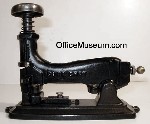
 |
Acme No. 1 Staple Binder
Advertised 1898-1950, likely sold after 1950
Acme Staple Co., Ltd.
Philadelphia, PA (1894-1909) & Camden, NJ (1909 onward) |
 |
Midget Stapler (first model)
Advertised 1901-28
Acme Staple Co., Ltd.
Philadelphia, PA (1894-1909) & Camden, NJ (1909 onward)
A second model of the Midget (not shown here) was a slight variation on the first model. The second model had an anvil with a sloped front. It was advertised 1925-36. A third model (shown later in the present table) was advertised 1936-50. |
 |
Simplex Stapler
Advertised 1903-31
Acme Staple Co., Ltd.
Philadelphia, PA (1894-1909) & Camden, NJ (1909 onward)
Later, Acme marketed a Simplex Stapler that was identical to the third model of the Midget Stapler (shown farther down in the present table). |
 |
Yarger No. 4 Staple Driver
Patented 1903 ~ Advertised 1906-22
S. J. Yarger, Philadelphia, PA |
 |
Acme No. 2 Stapler
Introduced 1908 ~ Advertised 1908-50
Acme Staple Co., Ltd.
Philadelphia, PA (1894-1909) & Camden, NJ (1909 onward) |
 |
Illico Stapling Machine
Advertised in Belgium c. 1910
Similar machines were advertised in the U.K. in the 1920s and patented in Germany 1929 and France 1937
Etabts O. Jansoone
Roubaix, France |
 |
Boston Automatic
Stapling Machine
Patented 1914 ~ Advertised 1923
Boston Wire Stitcher Co.
East Greenwich, RI
The nameplate on some machines shows a 1907 patent date, on others a 1914
patent date. The 1907 patent
relates only to a feature that appeared originally on a large foot-powered machine. According to a company history on bostitch.com, the machine pictured to the right was introduced in 1914 and was referred to as the Model AO. |


|
McGill's Lever Staple Press No. 75
Advertised 1920s
U.K.
Courtesy of Curtis Scaglione |
 |
McGill's Automatic
Paper Fastener No. 12
Advertised 1920s
U.K.
Courtesy of Curtis Scaglione |
 |
McGill's
Self-Feeding Staple Press No. 4
Advertised 1920s
U.K.
Courtesy of Curtis Scaglione |
 |
Bostitch B1 & B3 Staplers
Several Patent Applications 1922-34 ~ Several Patents Issued 1924-38
Boston Wire Stitcher Co.
East Greenwich, RI, and Portland, ME
A 1924 description indicated that the "magazine holds 210 staples" and that the machine "fastens 2 to 50 sheets."
The company began using the brand name "Bostitch" in marketing its staplers on Nov. 23, 1919, and obtained US Trademark No. 131,065 for this name in 1920.
A government document from 1923 refers to a purchase of Bostitch staplers. These may have been early B1's.
In any event, government documents from 1924 refer to purchases of Bostitch staplers for $3.75 each. Presumably these were B1's.
Some early B1's have the 1924 patent date and an indication that other patents were pending. These B1's may date from 1924-1926. The stapler to the right is slightly later. It has patent dates 1924-26.
|
 |
Speed Fastener 3 in 1 Stapler (a.k.a. Speed Fastener No. 50 and No. 100, Skrema Stitching Machine)
Patented 1924 (Germany) ~ Advertised 1925-28 (US)
Skrebba Works, Freiburg, Germany
Parrot Speed Fastener Corp., New York, NY (US Distributor)
Parrot Speed Fastener Corp. was incorporated in 1925. Initially it imported staplers from Germany. It began manufacturing them in the US in 1931. The company name became Speed Products in 1939 and then Swingline in 1956. (Chronology from Swingline.com, Nov. 21, 2013.) However, Speed Products was using "Swingline" as the brand name for its staplers and staples at least as early as 1946.
|
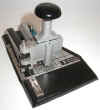 |
Hotchkiss Wire-Stapling Machine (a.k.a. Model 1A)
Introduced 1925 ~ Advertised 1925-30
E. H. Hotchkiss Co., Norwalk, CT
|
Picture coming
Schooley 1928 p. 62, Horder's 1928 catalog, or Omaha 1930, Price list, p. 90
|
Floris Stapler
Patented 1926 (Austria) ~ Advertised 1934 (Germany)
Austria or
Germany
|
 |
Babe Stapler (early model, top photo)
Introduced in U.S. 1928 ~ Advertised 1931 ~ Similar staplers were advertised in 1936 in Germany
Made in Germany
Parrot Speed Fastener Corp., New York, NY (US distributor)
A similar machine was advertised in 1929 as the Parrot No. 100.
Babe Stapler (late model, bottom photo)
Patent Application 1934 ~ US Patent No. 2,096,573 Issued 1937
Advertised 1936
Parrot Speed Fastener Corp., New York, NY (manufacturer)
The Curator has staples for a Babe, probably the late model but not sure, available for sale.
|
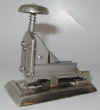
 |
Junior Stapler
Introduced and Advertised 1928
Acme Staple Co., Ltd.
Camden, NJ
|
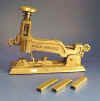 |
Hotchkiss 2A Stapler
Introduced 1928 ~ Advertised 1928-36
E. H. Hotchkiss Co., Norwalk, CT |
 |
Hotchkiss 1A (left)
& 3A-54 Staplers
1929 (left) & c. 1933
1A Advertised 1930. 3A Advertised 1936.
E. H. Hotchkiss Co., Norwalk, CT
The Hotchkiss 1A shown here was introduced in 1929. It replaced the
similar but lighter weight Hotchkiss Wire Stapling Machine (a.k.a. 1A)
that was introduced in 1926.
A Star Wire Stapler identical to the 1929 Hotchkiss 1A was sold by The Star Paper Fastener Co., Norwalk, CT.
Star seems to have been a company and brand name used by E. H. Hotchkiss Co.
In 1931, the “New, Improved” Hotchkiss Model 1A wire stapling machine came with an anvil with two positions. In one position, both legs were bent inward to form a normal staple. In the second position, one leg was bent inward and the other was bent outward, so the ends of the legs pointed in the same direction. The second position was designed to insert a temporary staple that could easily be removed.
The Hotchkiss 5A (not shown here) was advertised in 1936. |
 |
Kling-Tite Stapler
Patented 1933-34 (US Patent Nos. 1,919,373; 1,927,274; 1,978,983)
A. L. Hansen Mfg. Co.
Gurnee, IL |
 |
Ace Stapler Model No. 102
On market 1934-35 ~ Advertised 1936-74
Ace Fastener Corp.
Chicago, IL
In 1939, the Ace No. 102, at that point also called the Ace Standard Office Model, came with a two-position anvil. See bottom image to right (where the anvil is clearer than in the top photo). In one position, the legs were turned inward when the staple was clinched. In the other position, the legs were turned outward to make a temporary staple that could easily be pulled out as though it were a pin. |


|
Cadet Stapler Model No.
302
Advertised 1936-50
Ace Fastener Corp.
Chicago, IL
Cadet design changed by 1974, when it was a short version of the Aceliner.
The similar but longer Pilot Stapler Model No. 402 was advertised in 1936-74
and is still produced.
The larger No. 104 Duplex Fastener was advertised in 1936. |
 |
Neva-Clog Stapler Model
D-30
Advertised 1936-40
Neva-Clog Products
Bridgeport, CT
In 1936, Neva-Clog D-30 and D-40 staplers came with an anvil with two positions. In the first position, the legs were bent inward. In the second position each leg was bent outward to make a temporary staple. The straight staple could be pulled out in the same way as a straight pin. The Neva-Clog staplers could also be opened 180 degrees and used as tackers (without an anvil). |
 |
Midget Stapler (third model)
Advertised 1936-50
Acme Staple Co., Ltd., Camden, NJ
Acme marketed a Simplex Stapler identical to this third version of the Midget. |
 |
Aristocrat Stapler No. H-31
Advertised 1937
E. H. Hotchkiss Co.
Norwalk, CT |

 |
Speed Stapler No. 3 and No. 4
Patent Applications 1937 ~ Patents Issued 1938 (Design Nos. 110,796 to 800), 1941 (No. 2,267,719), 1946 (No. 2,424,649)
No. 3: On market 1938 ~ Advertised 1939-57
No. 4: Advertised 1939-61
Parrot Speed Fastener Corp. (until 1939), Speed Products Co. (1939-56), Swingline Inc. (1956 onward)
Long Island City, NYC
Speed Products Co. used "Swingline" as the brand name for its staplers and staples at least as early at 1946.
The Speed Stapler introduced an important innovation that made the loading of staples faster. Previously, to load a magazine stapler, one had to remove a plunger (or other mechanism to push staples forward) from the back of a stapler, insert a staple stick onto a rail at the back of the machine, and then replace the plunger. By contrast, one simply opened the Speed Stapler (see the second photo to the right), placed a staple stick on the rail, and closed the stapler. When the Speed Stapler was opened, the mechanism that pushed staples forward as they were used moved back out of the way; when the stapler was closed, that mechanism moved forward against the staple stick. This innovation gave the company an important marketing edge over competitors.
These staplers had a variety of exterior finishes. Immediately before and after World War II, they had nickel-plated bodies like the Swingline No.4 in the bottom photo. At other times, they were black, like the staplers in the first and third photos to the right. During 1957 they were grey (like the stapler in the second photo to the right), pearl, jade, or topaz. Model 3C had a wood base and presumably was marketed, at least initially,during WWII to save metal. The Model 3C in the third photo was produced by Speed Products Co., and therefore dates from 1939-56.
Generally the No. 3 and No. 4 had two-position anvils (like the Neva-Clog D-30), but the 3-C had a one-position anvil. |

No. 3 Black

Swingline No. 3 Grey open
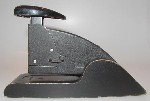
Speed Products No. 3C with wood base

Swingline No.4 with nickel-plated body
|
Scout Stapler Model No. 202
Patent Applications 1930-34 ~ Patented Issued 1936-38 (Nos. 2,033,018, 2,059,021, 2,066,157, 2,103,551, 2,107,169)
~ Version with concave spine (top photo) advertised 1939 ~
~ Version with convex spine (bottom photo) advertised 1939-74 ~
Ace Fastener Corp.
Chicago, IL
Some surviving Scouts with convex spines have colored metallic exteriors.
Scouts require special undulated chisel point staples, which are still available as Ace Clipper 70001 Staples from Shoplet.com |

 |
|
Electric Magazine Stapling Machines & a Manual Cartridge Stapler |
. |
|
Bostitch Electromagnetic Fastener (a.k.a. Bostitch Model 4)
Patent Application 1936 ~ First Marketed 1936 or 1937 ~ Patent Awarded 1937
Mentioned in trade press articles 1937 & 1938 ~ Advertised 1939
Boston Wire Stitcher Co.
This is the earliest known tabletop electric stapler. It's existence was rediscovered by Curtis Scaglione, whose research findings are on his website, MyStaplers.com.
This stapler may have been used to fasten papers in offices. However, it was clearly used in high speed, high volume commercial packaging. An article published in Packaging and Shipping in 1937 refers to $277 in savings a company obtained by using this machine to seal 350,000 one-pound bags of an unspecified product.
It is possible that this stapler was still on the market in the 1940s. An article published in Modern Packaging in 1944 refers to use of Bostitch electromagnetic staplers for packaging.
Some early electric stapler models, including this one and the Bates 56 below, had electric “hammers” or actuators that punched down on the knob on the top of a conventional manual stapler. The Bostitch Model 4 used a standard Bostitch B5 stapler mounted on a base with an electromagnetic hammer.
The base of the Bostitch Model 4 and the housing for the electromagnet are aluminum castings. The base with the stapler and the electromagnetic hammer is 14.25" long and weighs 7.5 lbs. A heavy duty 20-foot electric cable with a diameter of 0.5" runs from the electromagnet first to a foot pedal that was used to activate the hammer (causing the insertion of a staple) and then on to an electric outlet. The cast aluminum foot pedal weighs 5 lbs. The electric cable weighs another 4 lbs. The total weight of all the components is 16.5 lbs.
Cast onto the base of one surviving Bostitch Model 4 are the words "PAT. APPL'D FOR." This suggests that this machine, which has a serial number in the 1100's, was made between the patent application in 1936 and the award of the patent in 1937. Another surviving Model 4 has a serial number in the 4400's. This suggests that Bostitch made at least 4500 of these machines; however, manufacturers sometimes skipped over some serial numbers, so the number made may be lower. |
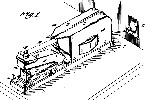
1937 patent drawing
Photo of Bostitch Model 4 to be added. |
Staplex Electric Stapler
Staplex has marketed electric stapling machines since 1949.
Models S54 and S56 were marketed in 1950.
Model SJM was advertised in 1974.
Staplex Co., Brooklyn, NY
Uses standard staples.
|
 |
Swingline Electric
Stapler Model 66
Patented 1959-60 ~ Advertised 1959-61, 1974
Swingline Inc.
Long Island City, NY
Swingline marketed an electric stapling machine in 1957.
|
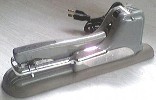 |
Bates Electric Stapler 56
Advertised 1957-74
The Bates Mfg. Co., Orange, NJ
The Bates 56 electric stapler contains a removable Bates 56 manual stapler that uses strips of 210 standard staples.
|
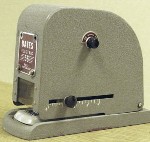
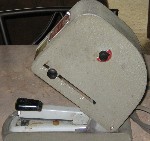 |
Swingline Electronic Stapler Model 68
Advertised 1974
Swingline Inc.
Long Island City, NY
This stapler used a coil with 10,000 staples. In the coil, the wire for each staple was straight and wires were side-by-side.
The wires were bent into staples inside the machine, then inserted and clinched.
|
 |
Swingline 790 Manual
Cartridge Stapler
Applications for patents 1981-85 ~ Application for patent for cartridge 1983 ~
Marketed at most briefly c. 1983
Swingline Inc.
Long Island City, NY
This stapler used a coil like the one used by the Model 68 above, but with 5,000 staples.
The same coil is used by the Swingline Zephyr electric stapler, which was introduced in 1983.
We have a duplicate of this stapler, loaded with a full coil of staples, mint in box with instructions, available for sale.
Click on the Curator button at the top of our home page to send us an email if you are interested.
|
 |
Swingline closed its US stapler production facilities in 1999 and sells imported staplers.
Return to Top of this Page
|



































